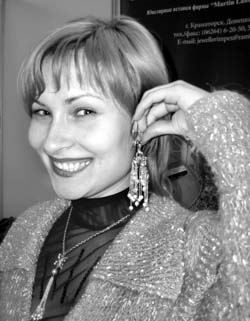Kharkiv seeks to become jewelry capital

Kharkiv’s last major exhibition of Ukrainian jewelry took place in 1998. Over the past eight years local jewelers have been working to revive this tradition. Last week’s exhibition “Jeweler Prestige” assembled nearly 60 major jewelry manufacturers from Ukraine, Russia, Moldova, China, and Turkey. By comparison, only 21 manufacturers showcased their jewelry at last year’s specialized exhibition “Jeweler Expo Donetsk.” Apart from displaying and selling jewelry, participants of the Kharkiv exhibition attended workshops to discuss the latest technologies, projects, and challenges facing this industry.
Exhibition organizer Viktor Loboda believes that “today a step has been taken in order to turn Kharkiv into a jewelry capital.” In the early 1990s Ukraine had no more than 10 factories producing a rather limited assortment of jewelry. Now Ukraine has nearly 900 manufacturers. The biggest are those in Kyiv, Vinnytsia, Kharkiv, Lviv, and Odesa. The one in Odesa is Aurum, a closed joint-stock company. While the output of jewelry reached 30 tons in 2003, in 2004 this figure was 42 tons, and in 2005, an impressive 60 tons of jewelry made from precious metals. Kharkiv’s 190 jewelry manufacturers account for 30 percent of the total output of jewelry in Ukraine, and this region is home to Ukraine’s oldest jewelry manufacturers.
Jewelry production began in Kharkiv in 1923. On the premises of a local state watch-making cooperative union, a shop was created to manufacture women’s jewelry from the by-products of the watch-making process. In 1973 the shop was renamed the Kharkiv Jewelry Plant, now a closed joint-stock company. The plant, which has its own accredited chemical laboratory, is home to Ukraine’s only monument to a jeweler. The sculpture is a collective image of a jewelry artisan displaying his creation — a silver jug — a typical product made in this factory, which was the first to start producing silverware in Ukraine. According to Viktor Tkachenko, the chairman of the board of the Kharkiv Jewelry Plant, the factory’s catalog features over 3,000 jewelry items.
Other Ukrainian jewelry manufacturers also have much to be proud of. The Kyiv Jewelry Plant, also an open joint-stock company, has over 5,000 items, and every month its stocks are replenished by 50 percent. Krystal, a Vinnytsia-based plant, manufactures diamonds that meet the high standards of international markets: the plant accounts for 3 percent of global diamond sales. This plant was established as part of a state program to develop the Soviet diamond and gem industry. Krystal is expected to become the world’s largest plant for cutting small- and average-sized diamonds. The plant cuts its diamonds into fancy shapes: pear, marquis, emerald, princess, oval, etc. The plant exports 95 percent of its products to Western Europe, the US, Southeast Asia, Israel, and Russia.
Experts are unanimous in saying that the Ukrainian jewelry industry is developing, and jewelry manufacturers want to learn as much as possible about their competitors. Meanwhile, these kinds of specialized exhibitions serve to reinforce the industry’s infrastructure.






